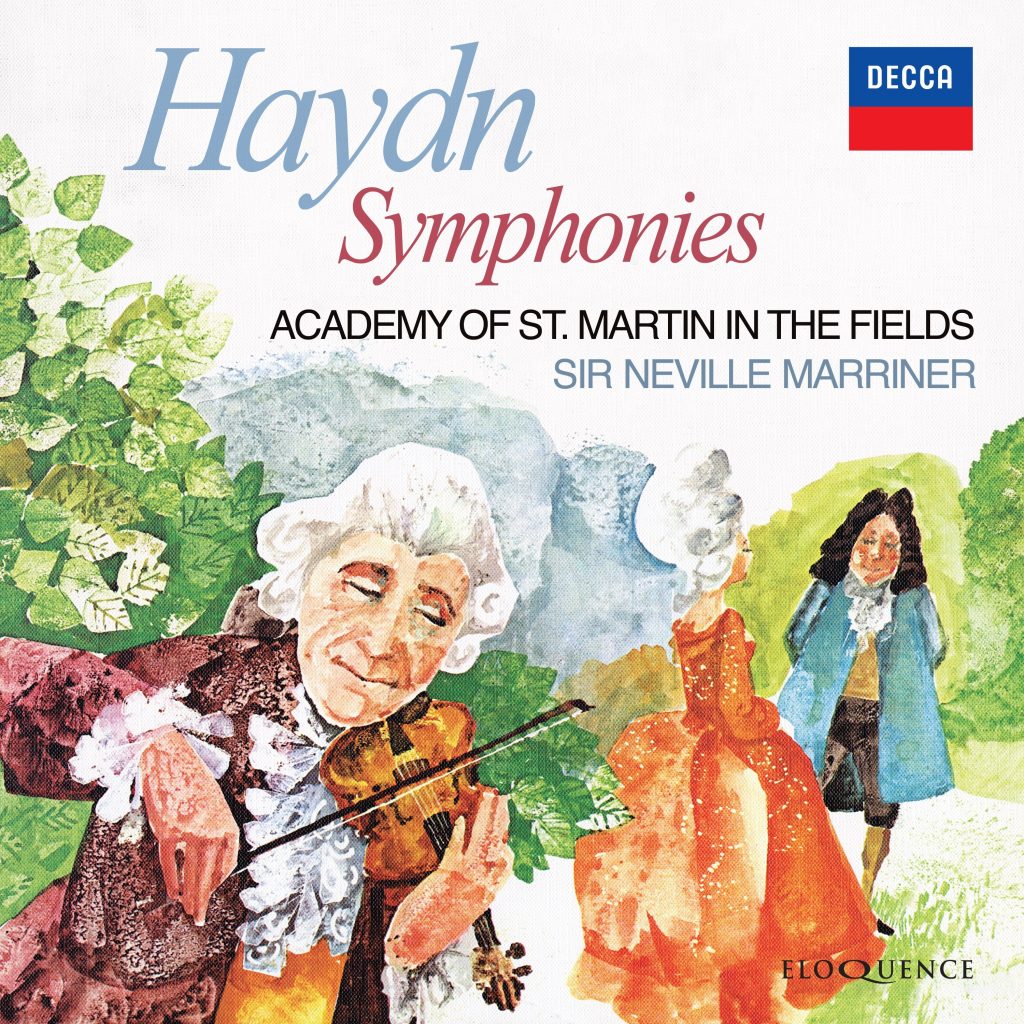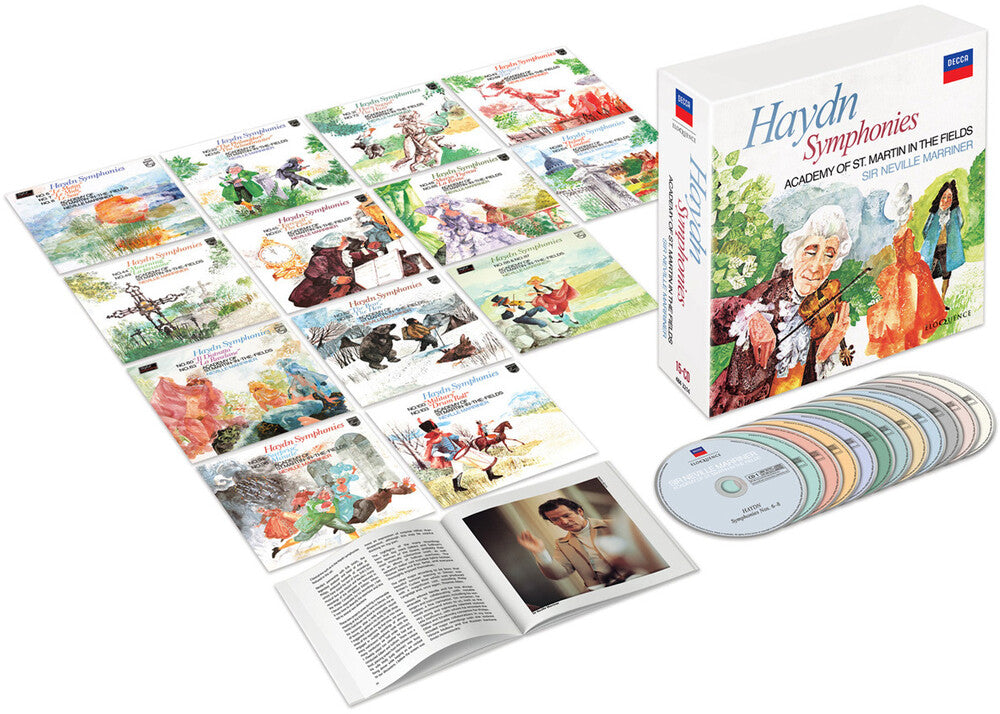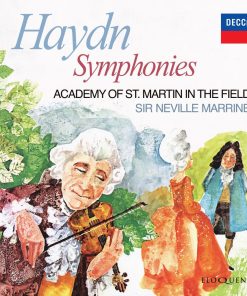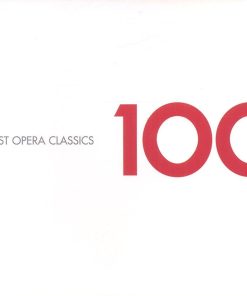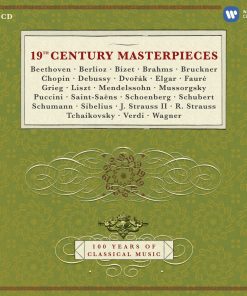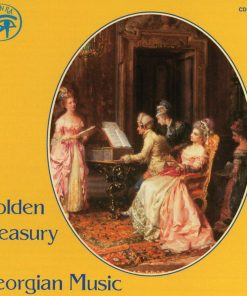HAYDN: 33 SYMPHONIES – Neville Marriner, The Academy of St. Martin in the Fields (15 CDs) DECCA
$ 109,99 $ 44,00
BONUS OFFER: BUY THIS SET AND GET A 10 CD BOXED SET OF HAYDN: A PORTRAIT, which includes “The Creation”, and numerous string quartets and piano sonatas. Click here for more information on this box.

With the delightful original LP cover illustrations, this ‘original jackets’ presentation collects together for the first time the 33 Haydn Symphonies recorded by Sir Neville Marriner and the Academy of St. Martin in the Fields over a twenty-year period, from 1970–1990. Both the polish and refinement of these performances, as well as the recording quality “of exceptional vividness and presence” (Gramophone), received widespread critical acclaim.
Begun in 1970 with an album of Symphonies Nos 52 & 53, this series of Haydn recordings soon concentrated on symphonies with nicknames (none of them supplied by the composer). They attracted widespread praise for the precision of their playing, the excellence of the Philips engineering and the unassuming polish and refinement of the readings, the only complaint being made that Marriner and his ensemble could not venture into all those other symphonic marvels which happened not to have attracted a nickname. Only towards the end of the series, in 1981, did they yield to this criticism by completing a set of the Paris symphonies with beautifully pointed accounts of Nos. 84, 86 and 87.
However, with 33 individual symphonies eventually recorded, the series covers a substantial fraction of Haydn’s legacy. Marriner took a flexible attitude to thorny academic issues such as whether or not to use a harpsichord continuo: ‘The most important thing is to be practical,’ he said, and the series conveys a meeting of minds across the centuries between two supremely practical musicians.
Some of these recordings last saw the light of day in a 1996 box of the ‘named’ symphonies. However, the present compilation restores the original couplings with ‘original jacket’ artwork. The booklet includes many session photographs of Marriner and the Academy in their natural habitat, as well as an enticing array of editorial contributions: from Max Harrison on Haydn’s inexhaustible invention as a symphonist, from Philip Stuart on the ins and outs of the ASMF Haydn discography, from Rob Cowan on Sir Neville Marriner as a director of unfailing style and vitality in this repertoire, and a personal memoir from Costa Pilavachi who worked with Marriner in his capacity as A&R manager and later head of the Philips Classics label.

“Marriner’s readings are marvels of rhythmic tension and zest, and are beautifully recorded.” Stereo Review, May 1972 (Nos. 52 & 53)
“The unrestrained Haydn collector will want this Philips disc simply because it’s so good.” High Fidelity, September 1972 (Nos. 52 & 53)
“Not only are these performances marvels of elegance, elan and precision, but the recording fits them flawlessly, with just the right blend of space and presence throughout.” Stereo Review, January 1978 (Nos. 100 & 103)
“The playing itself is of the very highest standard, and Philips match it with recordings of exceptional vividness and presence.” Gramophone, September 1978
“Adjectives as ‘delightful’, ‘lively’ and ‘stylish’ cannot begin to describe the combination of charm and integrity in these performances, which are not merely ‘lively’ but alive, filled with a wit and brilliance that are Haydn’s own.” Stereo Review, February 1978 (Nos. 43 & 59)
“Stunning realizations… each of which is invested in full measure with its own particular character. The tempos and instrumental balances are well-nigh unimprovable, and the substantial musical values are never subverted for gratuitous emphasis of the programmatic content implied by the titles.” Stereo Review, June 1978 (Nos. 44, 49 & 55)
“It would be difficult to imagine a more attractive or spirited performance … one is conscious of Marriner’s characteristically taut rhythmic control and his insistence on the utmost precision of ensemble.” Gramophone, July 1979 (Nos. 31 & 73)
“The performances are masterly … Marriner’s dynamic range has many subtle gradations. The Allegretto is played with the utmost delicacy and refinement, while in the finale the many inventive colour combinations are well realized.” High Fidelity, February 1980 (Nos. 82 & 83)
“The new performances have the same qualities of verve in the quick movements, sensitivity in the slow ones, and immaculate precision throughout that made the older ones so refreshing.” Gramophone, April 1982 (Paris Symphonies)
“In matters of tempo, phrasing, rhythmically vital and alert playing, these readings cannot be faulted, nor can the playing of the plethora of soloists headed by Iona Brown.” High Fidelity, October 1982 (Nos. 6, 7 & 8)
“The preferred edition on conventional instruments is clearly the recent Marriner, a succulent serving in juicy digital sound. This is the one to get for full justice to the scores’ musical content.” High Fidelity, May 1983 (Nos. 6, 7 & 8)
“Wholly enjoyable chamber-music performances of great style and precision.” Gramophone, October 1984 (Nos. 6, 7 & 8)
“Spirited and well-played accounts of the Paris Symphonies, distinguished by excellent ensemble and keen articulation.” Penguin Guide to Compact Discs, 1996


CD 1
Symphony No. 6 in D major, Hob. I:6 ‘Le Matin’
Symphony No. 7 in C major, Hob. I:7 ‘Le Midi’
Symphony No. 8 in G major, Hob. I:8 ‘Le Soir’
CD 2
Symphony No. 22 in E flat major, Hob. I:22 ‘Der Philosoph’ (The Philosopher)
Symphony No. 55 in E flat major, Hob. I:55 ‘Der Schulmeister’ (The Schoolmaster)
CD 3
Symphony No. 31 in D major, Hob. I:31 ‘mit dem Hornsignal’ (Horn Signal)
Symphony No. 73 in D major, Hob. I:‘La Chasse’ (The Hunt)
CD 4
Symphony No. 43 in E flat major, Hob. I:43 ‘Merkur’ (Mercury)
Symphony No. 59 in A major, Hob. I:59 ‘Feuer-Symphonie’ (Fire)
CD 5
Symphony No. 44 in E minor, Hob. I:44 ‘Trauer-Symphonie’ (Mourning)
Symphony No. 49 in F minor, Hob. I:49 ‘La Passione’ (Passion)
CD 6
Symphony No. 45 in F sharp minor, Hob. I:45 ‘Abschieds-Symphonie’ (Farewell)
Symphony No. 101 in D major, Hob. I:101 ‘The Clock’
CD 7
Symphony No. 48 in C major, Hob. I:48 ‘Maria Theresia’
Symphony No. 85 in B flat major, Hob. I:85 ‘La Reine’
CD 8
Symphony No. 52 in C minor, Hob. I:52
Symphony No. 53 in D major, Hob. I:53 ‘L’Impériale’ (Imperial)
CD 9
Symphony No. 60 in C major, Hob. I:60 ‘Il Distratto’
Symphony No. 63 in C major, Hob. I:63 ‘La Roxelane’
Symphony No. 69 in C major, Hob. I:69 ‘Laudon’
CD 10
Symphony No. 82 in C major, Hob. I:82 ‘L’Ours’ (The Bear)
Symphony No. 83 in G minor, Hob. I:83 ‘La Poule’ (The Hen)
CD 11
Symphony No. 84 in E flat major, Hob. I:84
Symphony No. 86 in D major, Hob. I:86
Symphony No. 87 in A major, Hob. I:87
CD 12
Symphony No. 92 in G major, Hob. I:92 ‘Oxford’
Symphony No. 104 in D major, Hob. I:104 ‘London’
CD 13
Symphony No. 94 in G major, Hob. I:94 ‘mit dem Paukenschlag’ (Surprise)
Symphony No. 96 in D major, Hob. I:96 ‘The Miracle’
CD 14
Symphony No. 99 in E flat major, Hob. I:99
Symphony No. 102 in B flat major, Hob. I:102
CD 15
Symphony No. 100 in G major, Hob. I:100 ‘Militaire’ (Military)
Symphony No. 103 in E flat major, Hob. I:103 ‘mit dem Paukenwirbel’ (Drum Roll)
Academy of St. Martin in the Fields
SIR NEVILLE MARRINER
STEREO RECORDINGS
Fast Shipping and Professional Packing
Due to our longstanding partnership with UPS FedEx DHL and other leading international carriers, we are able to provide a range of shipping options. Our warehouse staff are highly trained to pack your goods exactly according to the specifications that we supply. Your goods will undergo a thorough examination and will be safely packaged prior to being sent out. Everyday we deliver hundreds of packages to our customers from all over the world. This is an indication of our dedication to being the largest online retailer worldwide. Warehouses and distribution centers can be located in Europe as well as the USA.
Orders with more than 1 item are assigned processing periods for each item.
Before shipment, all ordered products will be thoroughly inspected. Today, most orders will be shipped within 48 hours. The estimated delivery time is between 3-7 days.
Returns
The stock is constantly changing. It's not entirely managed by us since we are involved with multiple parties such as the factory and our storage. The actual stock can fluctuate at any time. Please understand it may happen that your order will be out of stock when the order is placed.
Our policy is valid for 30 days. If you haven't received your product within 30 days, we're not able to issue either a return or exchange.
You are able to return a product if it is unused and in the same condition when you received it. It must also still remain in the original packaging.
Related products
MUSIC CDS
MUSIC CDS
MUSIC CDS
MUSIC CDS
MUSIC CDS
MUSIC CDS
MUSIC CDS
MUSIC CDS
MUSIC CDS
